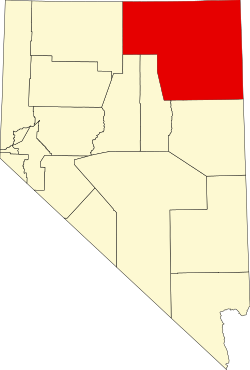Elko County | |
|---|---|
 Elko County Courthouse in Elko | |
 Location within the U.S. state of Nevada | |
 Nevada's location within the U.S. | |
| Coordinates: 41°08′N115°21′W / 41.13°N 115.35°W | |
| Country | |
| State | |
| Founded | 1869 |
| Named after | Elko |
| Seat | Elko |
| Largest city | Elko |
| Area | |
• Total | 17,203 sq mi (44,560 km2) |
| • Land | 17,170 sq mi (44,500 km2) |
| • Water | 33 sq mi (90 km2) 0.2% |
| Population (2020) | |
• Total | 53,702 |
• Estimate (2024) | 54,363 |
| • Density | 3.1/sq mi (1.2/km2) |
| Time zones | |
| Majority of county [1] | UTC−8 (Pacific) |
| • Summer (DST) | UTC−7 (PDT) |
| West Wendover [2] | UTC−7 (Mountain) |
| • Summer (DST) | UTC−6 (MDT) |
| Congressional district | 2nd |
| Website | elkocountynv |
Elko County is a county in the northeastern corner of Nevada, United States. As of the 2020 census, the population was 53,702. [3] Its county seat is Elko. [4] The county was established on March 5, 1869, from Lander County. Elko County is the fourth-largest county by area in the contiguous United States, ranking lower when the boroughs of Alaska are included. It is one of only 10 counties in the U.S. with more than 10,000 square miles (25,900 km2) of area. Elko County is the second-largest county by area in Nevada, with only Nye County being larger. Elko County is part of the Elko micropolitan statistical area. It contains 49.8 percent of the Duck Valley Indian Reservation, set up in the late 19th century for the Shoshone-Paiute peoples; they are a federally recognized tribe. Although slightly more than 50% of the reservation is across the border in Owyhee County, Idaho, the majority of tribal members live on the Nevada side. The reservation's land area is 450.391 square miles (1,166.5 km2).



